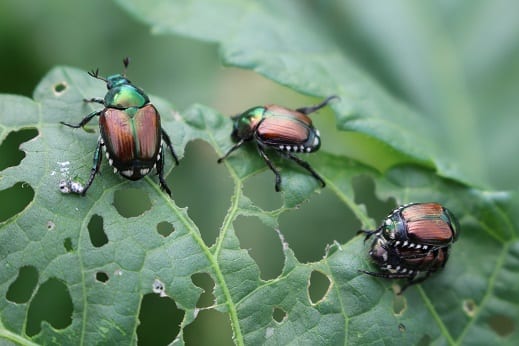
21 May Japanese Beetles – Time to treat before they eat!
It is time to treat for Japanese Beetles before they eat! This month we are talking about Japanese beetles and how to prevent them before they become a threat to your plants. Japanese beetles are one of the largest insect pests in the midwest causing devastating damage to farm crops and residential gardens each year.
These coppery-winged pests lay eggs in the ground the first part of summer, which turn into tiny white grubs. The Grubs will winter underground and remain there for about ten months feeding on plant and grassroots, before emerging as beetles in June to feed on plants and start the life cycle again. To read more about grubs, click HERE to visit our blog post on them from last season.
As your trusted lawn care partner, our goal is to treat your lawn for grubs now as a preventative measure before they grow into beetles and cause havoc to your plant life. If you wait to call us in June when you find your first skeletonized looking leaf, it could be too late. They can destroy an 8-foot tall bush in a couple of days; imagine how quickly they could harm a small rose bush or green bean plant if you have a vegetable garden!
There are some natural preventative measures you can take to help manage Japanese beetles. Opt for plants that Japanese beetles are less likely to be attracted to, like Boxwood, Lilac, Burning Bush, and Clematis. Use the companion planting method to plant more strategically with plants that deter pests—planting Garlic near affected plants to prevent the beetles from feeding on plants in that area.
Having Japanese beetles in your yard doesn’t have to mean the end of your plant life. As part of our fertilizer+ program, we have an application built-in to treat the grubs that later turn into beetles. With proper planning and applications from our expert lawn maintenance team, we can take the guesswork out of managing your coppery-winged pests! Give us a call today!
Photo Credit: K-State Blog, Kansas State University


